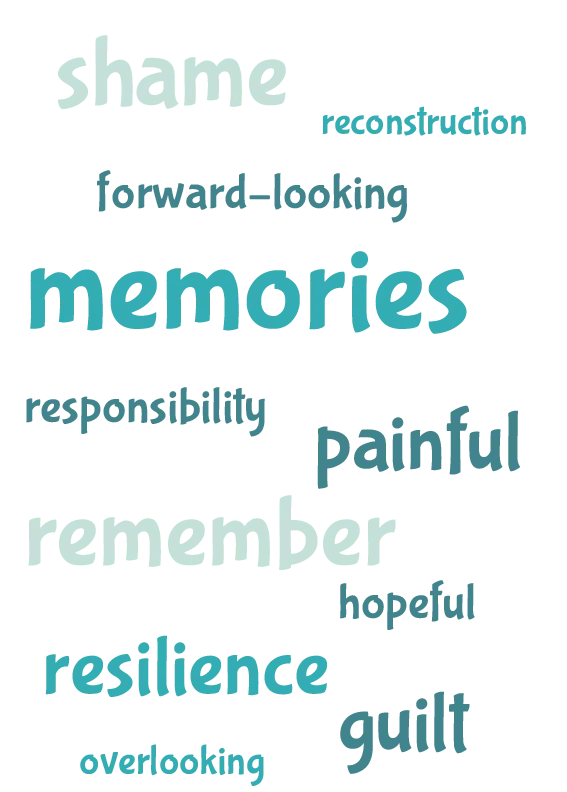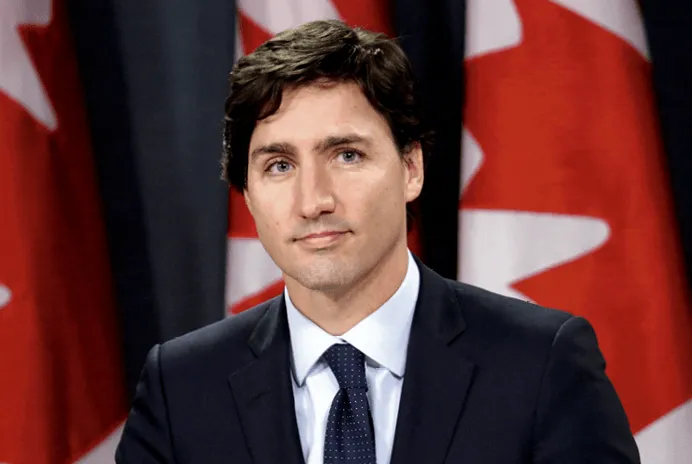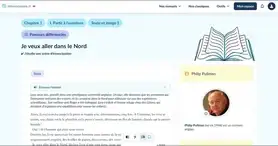Unit 1
Bac
Exam file
Préparation aux évaluations communes
Ressource affichée de l'autre côté.
Faites défiler pour voir la suite.
Faites défiler pour voir la suite.
Évaluations communes
1H30Ressource affichée de l'autre côté.
Faites défiler pour voir la suite.
Faites défiler pour voir la suite.
Compréhension de l'oral Justin Trudeau Shares His Experience with the Truth and Reconciliation Commission
1
Avant l'écouteLisez le titre ci-dessus et regardez le nuage de mots.
a. Sur quoi peut porter cet enregistrement ? Faites trois hypothèses.
b. Trouvez cinq autres mots que vous pourriez entendre dans l'enregistrement.
2
Après l'écouteEn rendant compte, en français, du document, vous montrerez que vous avez compris les éléments suivants :
- Le thème principal du document ;
- À qui s'adresse le document ;
- Le déroulement des faits, la situation, les événements, les informations ;
- L'identité des personnes ou des personnages et, éventuellement, les liens entre elles / entre eux ;
- Les éventuels différents points de vue ;
- Les éventuels éléments implicites du document ;
- La fonction et la portée du document (relater, informer, convaincre, critiquer, dénoncer, etc.).
Ressource affichée de l'autre côté.
Faites défiler pour voir la suite.
Faites défiler pour voir la suite.
Justin Trudeau shares his school experience with the Truth and Reconciliation Commission, CBC News, 2015.
Ressource affichée de l'autre côté.
Faites défiler pour voir la suite.
Faites défiler pour voir la suite.


Ressource affichée de l'autre côté.
Faites défiler pour voir la suite.
Faites défiler pour voir la suite.


Justin Trudeau, 2016.
Ressource affichée de l'autre côté.
Faites défiler pour voir la suite.
Faites défiler pour voir la suite.
Expression écrite
Choisissez un sujet et répondez-y en anglais en 120 mots minimum.
Sujet A - Texte
Do you understand the need of these
teenagers to learn and speak the language of their ancestors?
Sujet B - Texte - Vidéo
Prime Minister Justin Trudeau
met Quinn Meawasige at the inauguration of a museum about
Aboriginal art. Imagine their conversation.
Sujet C - Vidéo
•Justin Trudeau's former history teacher
heard his speech and decided to react to it. Imagine the letter
he or she wrote.
Ressource affichée de l'autre côté.
Faites défiler pour voir la suite.
Faites défiler pour voir la suite.
- Sujet A : Répondez à la question seulement après avoir développé vos arguments. Utilisez des mots de liaison pour relier vos arguments.
- Sujet B : Respectez les règles de présentation et de ponctuation du dialogue en anglais.
- Sujet C : Présentez votre écrit comme une lettre et veillez à respecter le ton formel qu'impose ici le sujet.
Ressource affichée de l'autre côté.
Faites défiler pour voir la suite.
Faites défiler pour voir la suite.
Compréhension de l'écrit
“Canada's indigenous people raise voices as youth activism surges”
Quinn Meawasige says he has spent his life walking with “one foot in a moccasin and one foot in a sneaker”.
The indigenous activist and youth council representative with the Assembly of First Nations (AFN), Meawasige learned to balance both those worlds when he discovered his Aboriginal roots and heritage in a self-imposed stint in rehab as a struggling teenager.
Meawasige, now 21, is far from alone among young indigenous Canadians who are forging a new path paved with old traditions.
There are over 1.4 million aboriginal people in Canada, with the majority of the population now under 25.
More than 45% of on-reserve youth say learning a First Nations language is very important to them, and just over half of them can understand or speak a First Nations language. A 2014 report from the British Columbia Language Initiative – which seeks to revitalize the province's First Nations languages – found that the number of semi-fluent speakers had risen significantly since 2010.
The embrace of the language comes as Canada's aboriginal youth are increasingly finding their voice in culture and politics. […]
“It's a wave of young people who want to retain their language, who want to contribute to Western society but also make sure they're rooted and grounded in their culture,” said Meawasige.
Indigenous activism has taken many forms, from the electronic powwow music of A Tribe Called Red to the flash mobs of the Idle No More movement.
Ashley Callingbull made history this year by becoming the first Aboriginal woman to be crowned Mrs Universe – and then calling on First Nations people to vote Conservative prime minister Stephen Harper out of office in the 19 October federal election, criticizing what she called his government's adversarial approach to First Nations.
Brian Maracle, program coordinator of the Onkwawenna Kentyohkwa Mohawk language school outside Toronto, said he's witnessed the shift since the school opened in 1999.
“Sixteen years ago, our typical student was a middle-aged grandmother,” he said. “And now our typical student is someone in their 20s, maybe even a teenager.”
And he's noticed his younger students are using the language in new ways.
“They want to be part of this new culture with social media and rap and things like that. They want to do it their way. I'm really surprised at the determination of these young people to use the language and use the language only. They want to function entirely – in our case Mohawk – that's how they want to live their lives.”
Still, of Canada's roughly 60 indigenous languages, only Cree, Ojibwa and Inuktituk – an Inuit language – are currently predicted to survive.
The indigenous activist and youth council representative with the Assembly of First Nations (AFN), Meawasige learned to balance both those worlds when he discovered his Aboriginal roots and heritage in a self-imposed stint in rehab as a struggling teenager.
Meawasige, now 21, is far from alone among young indigenous Canadians who are forging a new path paved with old traditions.
There are over 1.4 million aboriginal people in Canada, with the majority of the population now under 25.
More than 45% of on-reserve youth say learning a First Nations language is very important to them, and just over half of them can understand or speak a First Nations language. A 2014 report from the British Columbia Language Initiative – which seeks to revitalize the province's First Nations languages – found that the number of semi-fluent speakers had risen significantly since 2010.
The embrace of the language comes as Canada's aboriginal youth are increasingly finding their voice in culture and politics. […]
“It's a wave of young people who want to retain their language, who want to contribute to Western society but also make sure they're rooted and grounded in their culture,” said Meawasige.
Indigenous activism has taken many forms, from the electronic powwow music of A Tribe Called Red to the flash mobs of the Idle No More movement.
Ashley Callingbull made history this year by becoming the first Aboriginal woman to be crowned Mrs Universe – and then calling on First Nations people to vote Conservative prime minister Stephen Harper out of office in the 19 October federal election, criticizing what she called his government's adversarial approach to First Nations.
Brian Maracle, program coordinator of the Onkwawenna Kentyohkwa Mohawk language school outside Toronto, said he's witnessed the shift since the school opened in 1999.
“Sixteen years ago, our typical student was a middle-aged grandmother,” he said. “And now our typical student is someone in their 20s, maybe even a teenager.”
And he's noticed his younger students are using the language in new ways.
“They want to be part of this new culture with social media and rap and things like that. They want to do it their way. I'm really surprised at the determination of these young people to use the language and use the language only. They want to function entirely – in our case Mohawk – that's how they want to live their lives.”
Still, of Canada's roughly 60 indigenous languages, only Cree, Ojibwa and Inuktituk – an Inuit language – are currently predicted to survive.
Ressource affichée de l'autre côté.
Faites défiler pour voir la suite.
Faites défiler pour voir la suite.
Questions
a) Explain in your
words the passage in bold letters.
b) Pick out words from the lexical field of duality in the text.
c) In your opinion, what does “on-reserve” mean?
d) Who is Ashley Callingbull? What did she do? Why do you think she did it?
e) What change is highlighted here? According to you, why is it happening?
b) Pick out words from the lexical field of duality in the text.
c) In your opinion, what does “on-reserve” mean?
d) Who is Ashley Callingbull? What did she do? Why do you think she did it?
e) What change is highlighted here? According to you, why is it happening?
Une erreur sur la page ? Une idée à proposer ?
Nos manuels sont collaboratifs, n'hésitez pas à nous en faire part.
j'ai une idée !
Oups, une coquille


